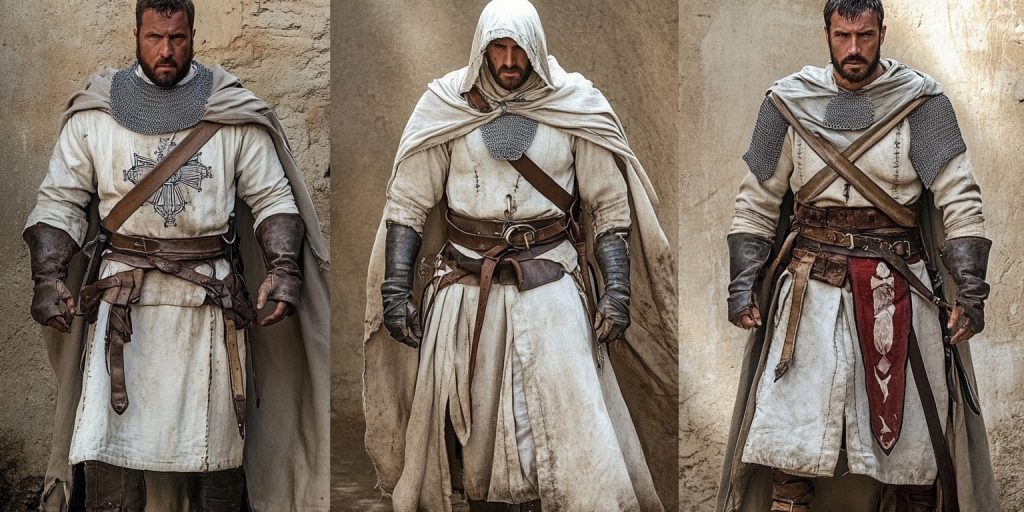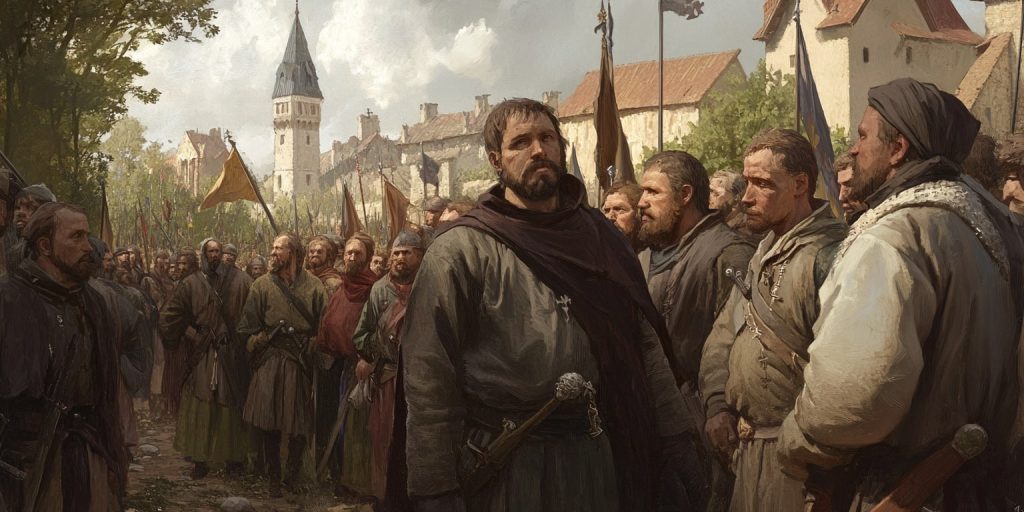The clothes peasants wore in medieval times tell us a lot about life back then. They were simple and practical, in sharp contrast to the Templars, a group of monks who were also warriors.
Looking at their clothes, we see how different their lives were in the Middle Ages. The Templars’ fancy clothes show they were important, showing the big gap between rich and poor back then.
Understanding the Attire of Medieval Peasants
In medieval Europe, clothes were shaped by social class and jobs. Poor clothes were made to last for daily work. Peasants wore long tunics or dresses from wool and linen. These kept them warm and safe from the weather.
What did medieval peasants wear? They chose simple clothes that showed their life. Common items were:
- Long tunics reaching the knees or lower
- Simple dresses for women that allowed ease of movement
- Pants or breeches for men
Fabrics were key for peasant clothes. They used easy-to-find materials that could be repaired and reused, which fit the peasants’ economic needs. Clothes also had to be practical and modest, fitting their rural roles.
Looking at peasant clothes helps us understand their lives and society during the medieval period. It shows us what they wore and their values and challenges.
Material Composition of Peasant Clothing
Peasants chose their clothes wisely. Linen and wool were key. They made clothes comfortable, durable, and practical, reflecting the needs of the medieval European lifestyle. This shows how clever the lower classes were in the medieval period regarding fashion.
The Role of Linen in Everyday Wear
In medieval Europe, linen was the go-to for daily clothes, especially undergarments and summer outfits. It kept peasants cool while they worked. The linen was plain, but it was cheap and easy to find.
This made it a must-have for many peasants.
Wool: A Commonly Used Material
Wool was vital for outerwear because it kept peasants warm. It was good for all kinds of weather: coarser wool was for cold, finer wool for milder times.
The quality of wool changed by region, allowing peasants to pick clothes that fit their needs. This shows how practical they had to be with their choices.
What Did Peasants Wear in Medieval Times
In medieval times, peasants wore simple clothes. These clothes were made for work, lasted long, and felt good. They also showed who a person was in society during the medieval period.

Basic Garments: Tunics and Smocks
Tunics were key for both men and women. They were knee-length and had a belt at the waist, typical for clothing in the medieval era. This made it easy to move around while working.
Tunics and smocks were made to be helpful, not fancy, and were must-haves for peasants. They were worn on top for extra warmth and protection.
Undergarments: Braies and Shifts
Undergarments were key for comfort. Men wore braies and loose shorts tied at the waist to stay comfortable while working hard.
Women wore shifts under their tunics. These were made of linen for breathability. Together, tunics, smocks, braies, and shifts made up peasant clothes. They were all about being simple and useful.
The Footwear of the Lower Classes
Medieval footwear for the lower classes was all about being useful and lasting long. Shoes were made from leather or rough fabric. They were perfect for peasants who worked hard daily in the Middle Ages.
Stockings, made from wool or linen, were a big deal for these people in the context of poor Middle Ages clothing. They kept their feet warm and protected, especially when people went barefoot.
Stockings and Their Significance
Stockings, made from wool or linen, were key for the lower classes. They kept feet warm and soaked up sweat, making work more comfortable.
Common Footwear Styles
Peasant shoes came in simple yet effective designs. The “poulaines” were popular because of their pointed toes and leather material. They offered protection and allowed for easy movement.
- Leather construction for durability
- Simple designs to accommodate practicality
- Varied styles influenced by seasonal needs
The footwear choices showed the economic limits and lifestyle of peasants. They also showed how regional influences shaped their clothing, giving us a better understanding of medieval clothing history.
Comparing Peasant Clothing with Templar Attire
Peasant and Templar clothes show the big differences in medieval society. Peasants wore simple clothes for work, while Templars had fancy clothes made of expensive materials, which showed their high status.
This difference shows the wealth and power gap between the upper and lower classes and how society was organized at that time.

Distinctive Features of Templar Dress
Templar clothes were known for their detailed designs and fine fabrics like silk. They often had special symbols, like the red cross. This was different from peasants, who wore simple clothes made of wool and linen.
The fancy Templar clothes were not just for looks. They also protected the Templars in battle and showed their high social status.
How Templar Clothing Symbolized Their Status
Templar clothes meant more than just style. They showed their values and roles in society. Their clothes showed they were loyal, honorable, and faithful.
This made them respected in society. Peasants wore clothes that showed they were just trying to survive in the Middle Ages, while Templars wore clothes that showed their wealth and power.

